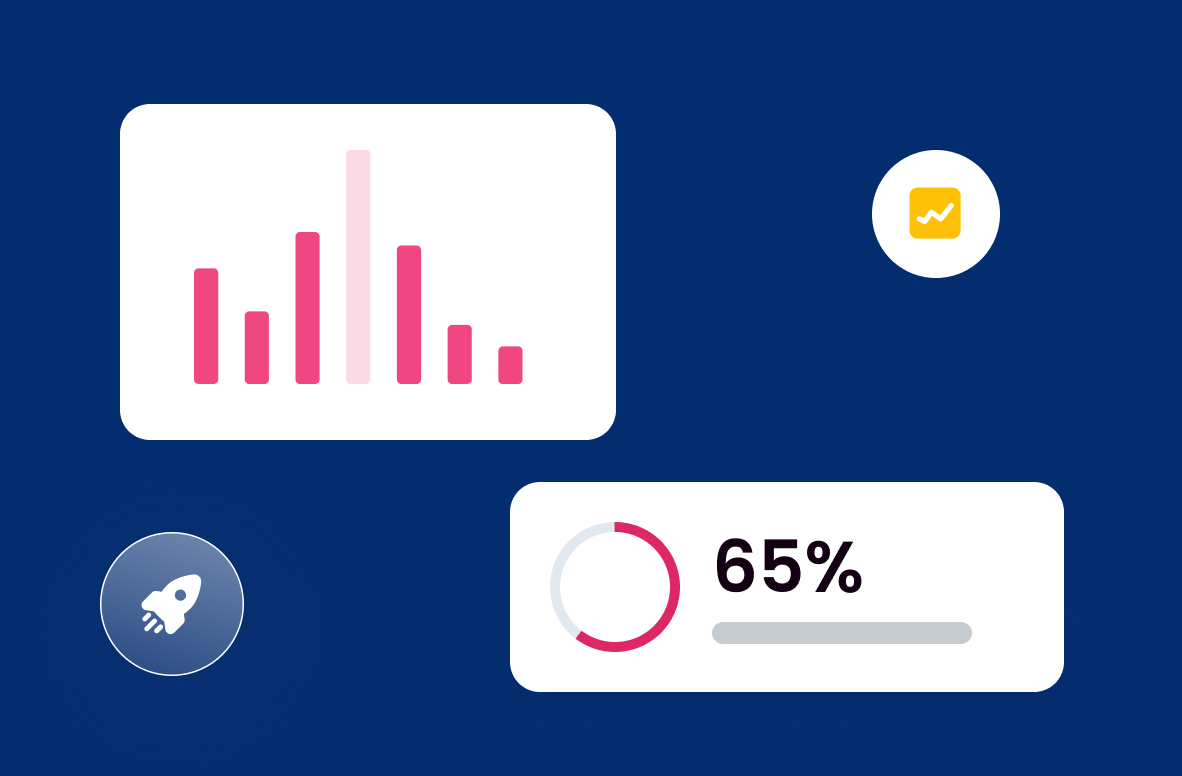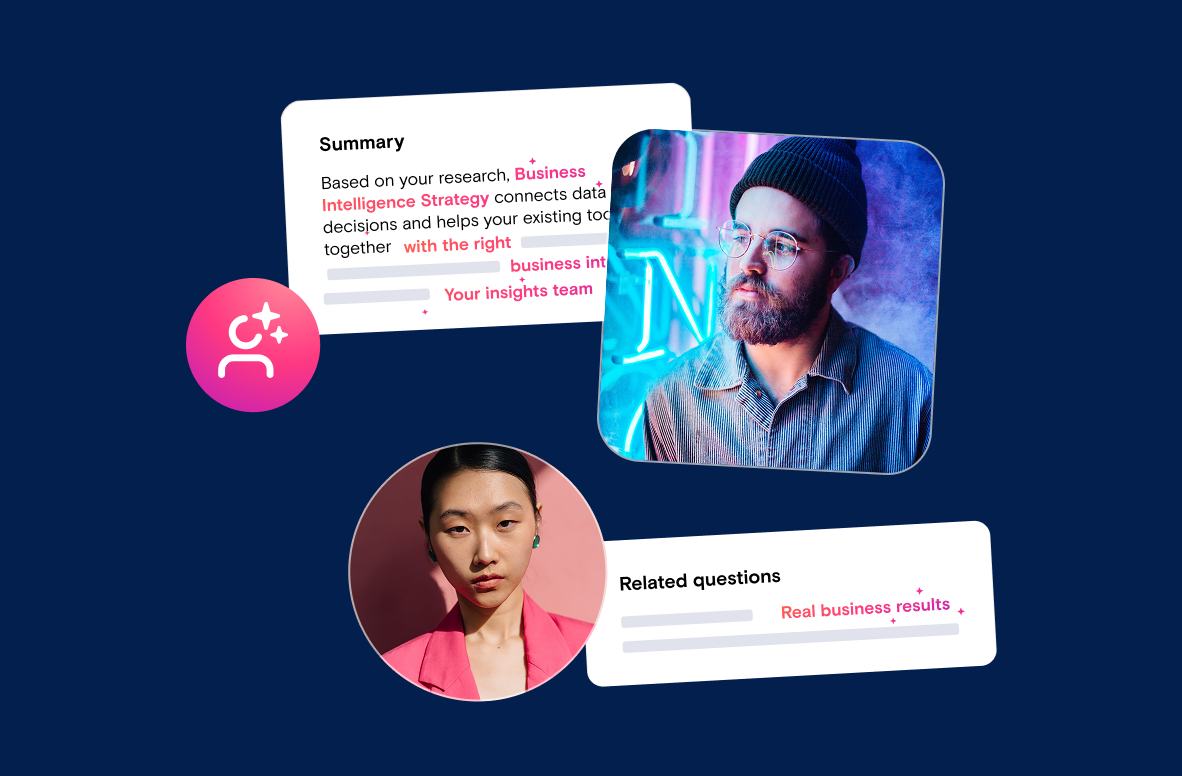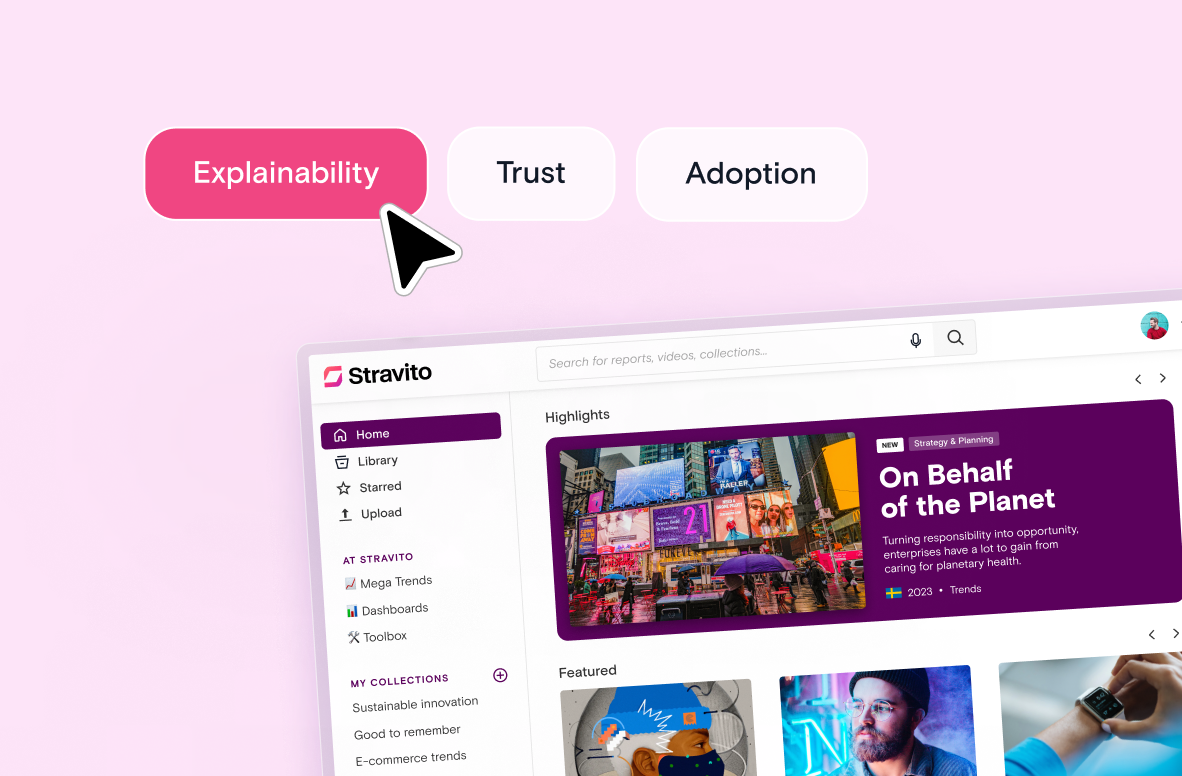TL;DR
- Customer intelligence (CI) gives enterprises a deeper understanding of customer behavior, needs, expectations, and customer satisfaction.
- CI goes beyond business intelligence and CRM by combining structured, quantitative data with unstructured, qualitative data.
- An effective customer intelligence strategy includes collecting, unifying, analyzing, and activating CI data across teams.
- Stravito helps operationalize CI by centralizing research and knowledge, improving findability, enabling cross-functional usage, and protecting customer privacy.
Insights teams are under pressure to deliver more than numbers. Business leaders want context, foresight, and a clear link to growth. Customer intelligence is how you move from reporting to real impact, and why customer intelligence is important for long-term business outcomes.
Insights leaders like you know the frustration of having endless data but still struggling to answer the questions that matter most. Business Intelligence and customer analytics can show the what and how much, but they rarely explain the why.
- What do our customers really need?
- Why are they choosing us or leaving us?
- Where should we focus next?
That gap between raw data and real understanding is exactly what customer intelligence is designed to close.
You’ll walk away with a framework for customer intelligence that helps you connect data points, uncover actionable insights, and drive growth across your organization.
But why does customer intelligence often feel out of reach, and what is really standing in the way?
Start with the problem your teams feel
Even with dashboards, reports, and analytics systems in place, leaders still run into the same roadblocks.
- Dashboards exist, but people still ask for the story.
Business intelligence shows what happened, but it rarely explains customer behavior or customer expectations. Teams need customer insights, not just charts, to build stronger customer relationships and customer satisfaction
- Research is scattered in drives and inboxes.
Customer intelligence data lives across shared folders, email threads, and analyst decks. Collecting customer data is easy, but finding the right report wastes time, slows marketing efforts, and often leads to duplicate work.
- Regions run in different languages and tools.
Market research, customer feedback, and unstructured data get locked in silos. That makes it hard to connect insights across countries, customer interactions, and customer touch points.
- Decisions stall because no one can find the prior work.
Stakeholders expect actionable insights fast. Without access to comprehensive data and past customer intelligence efforts, teams struggle to make informed decisions or deliver business outcomes with confidence.
These challenges are why customer intelligence is important.
It pairs metrics with meaning and keeps the evidence in one place so your organization can act faster, protect customer privacy, and achieve measurable business growth.
Customer intelligence: A working definition leaders can repeat
Customer intelligence is how your company learns from customers at scale and uses that knowledge to guide product, marketing, sales, and CX. It is one of the key benefits of moving beyond business intelligence or customer analytics because it turns customer data into knowledge that leaders can act on.
It blends four lenses:
- Who customers are. Identity, context, and attributes that define individual customers and segments
- What they do. Behavioral data, transactional data, and purchase history that show the customer journey in action
- What they think. Customer feedback, sentiment analysis, and attitudinal signals gathered from qualitative data, quantitative data, and social media posts
- Why it matters. The motivations revealed in research, unstructured data, and third-party data that create a deeper understanding of consumer behavior
In short, customer intelligence connects customer data with customer insights to create actionable knowledge. It is what makes customer intelligence important for customer satisfaction, customer retention, and stronger customer relationships.
It also explains why client intelligence and customer data intelligence efforts must be tied to an effective customer intelligence strategy.
When you leverage customer intelligence, you move from analyzing data to making informed decisions that improve customer experience, protect customer privacy, and drive business growth.
The next step is making it practical. That starts with the “One Place” model for keeping customer knowledge findable.
The “One Place” model: How to keep customer knowledge findable
Customer intelligence only delivers value if people can actually find and use it. That is why customer intelligence is important for every enterprise. The most effective way to make that happen is to centralize both the story and the source. This is the principle behind the “One Place” model.
What goes in the “One Place”
Your single hub should bring together the different types of customer knowledge and CI data that sit scattered across tools and teams.
At a minimum, include these core data sources:
- Research reports and summaries, including comprehensive data from market trends and historical data
- Customer feedback and transcripts that reflect customer satisfaction, customer expectations, and customer needs
- Win or loss notes, purchase history, and call clips that highlight customer behavior and identify at-risk customers
- Competitive snapshots, analyst notes, and guidance from the best customer insights tools
- Links to BI dashboards and analytics systems that show the metrics behind the story and connect marketing efforts with customer intelligence strategy
This mix gives stakeholders both the evidence and the context. It turns raw data into actionable insights, making it easier to inform business outcomes and drive customer success.
How Stravito makes “One Place” real
Centralizing knowledge sounds simple, but in practice, most enterprises struggle with scattered tools, silos, and inconsistent processes.
Stravito makes it easy to put the "One Place" model into practice by giving teams a secure hub that combines customer data, research, and analytics systems into one easy-to-use platform.
- Drag and drop to import. Bring in documents, recordings, and links without IT support. This includes research PDFs, interview notes, win or loss docs, and customer intelligence examples from analyst reports.
- Semantic search. Find customer signals fast across PDFs, slides, and video, even in multiple languages. This turns unstructured data into actionable insights and supports faster marketing strategies.
- Curated Collections. Package insights by theme, market, persona, or initiative. Collections reduce duplicate work and show key stakeholders both the metrics and the story in one place.
- AI-powered support. Use AI knowledge management to summarize, compare, and analyze customer intelligence data. Machine learning algorithms and advanced analytics surface contradictions, psychographic data, and customer preferences so business leaders can make informed decisions.
- Tailored digests. Push insights directly to product, CX, sales, and leadership teams. This helps gain customer insights, making it an ongoing process instead of a one-off project. Personalized marketing and stronger customer relationships follow when the right insights reach the right teams.
Stravito turns CI data into comprehensive data that organizations can act on.
It also protects customer privacy, supports compliance with GDPR in Europe and the California Consumer Privacy Act in the U.S., and ensures customer intelligence efforts actually deliver business growth.
What to collect: the smallest useful set of signals
Customer intelligence doesn’t require endless data. It works best when you focus on a core set of signals that help you understand customer behavior, expectations, and preferences.
Collecting too much creates noise.
Collecting the right mix creates valuable insights that lead to informed decisions and measurable business outcomes.
Identity and context
Start with the basics that define who your customers are and the environment they operate in.
- Segments or personas, account attributes, and demographics
- Market or region, language, and cultural factors
- Context from competitive intelligence snapshots and analyst reports
These signals help you build a customer-first organization that knows not just what people buy, but why they buy it. This is one of the key benefits of customer intelligence.
Behavioral and transactional data
Behavioral data and transactional data reveal what customers actually do.
- Product usage events and purchase history
- Return data, subscription status, and average order value
- Customer journey patterns across customer interactions, touch points, and digital engagement
Together, these data points highlight opportunities for customer retention, customer lifetime value, and stronger customer relationships. They also create CI data that can be used in analytics systems to identify at-risk customers.
Qualitative and attitudinal data
Numbers alone don’t explain motivations. Attitudinal and qualitative data show how customers feel and what they expect.
- NPS, CSAT, and other customer satisfaction metrics
- Open-ended verbatims, reviews, and social media posts
- Interviews, support tickets, and transcripts for sentiment analysis
These sources provide actionable insights about customer expectations, loyalty, and success that pure quantitative data would miss. They’re essential to an effective customer intelligence strategy and to leveraging customer intelligence for growth.
Competitive and market intelligence
To put customer intelligence data in context, you need external signals.
- Competitor claims and pricing changes
- Category and assortment trends
- Market trends captured in third-party data and historical data
This layer connects customer needs with external pressures, making your marketing strategies more relevant and your customer intelligence efforts more sustainable.
To dive deeper, explore practical advice on how to gain customer insights.
With the right signals in place, the next step is turning them into a repeatable playbook. That’s where a Stravito-first approach makes customer intelligence easy to activate.
The Stravito-first CI playbook: Step by step
Customer intelligence only drives value when it becomes a habit.
This playbook gives you a clear path to move from scattered assets to an effective customer intelligence strategy.
Each step is designed to cut through complexity, deliver actionable insights, and prove business outcomes.
Step 1: Inventory and import
Start by making a one-page list of where your customer knowledge lives today. Then pull the 50 most-used assets into Stravito.
- Research PDFs, slide decks, interview notes, win or loss docs
- Customer feedback and support transcripts
- Links to BI dashboards supported by AI knowledge management
Outcome: The best 20 percent of content that answers 80 percent of questions is in one place, ready for analysis and activation.
Step 2: Define a shared taxonomy
Customer intelligence efforts break down if teams use different languages. Create 10 to 15 starter tags and maintain them consistently.
- Journey stage, theme, issue type, segment, market, language, product, competitor
- Save definitions in Stravito so key stakeholders always share the same understanding
Outcome: Everyone uses the same language for the same data points, which makes collaboration easier.
Step 3: Tag and enrich content in Stravito
Apply the taxonomy to your imported assets and enrich them for faster discovery.
- Add short summaries, owners, and context
- Use Stravito’s AI Assistant to create bullet key takeaways per asset
- Highlight customer intelligence examples that show retention, loyalty, or identifying at-risk customers
Outcome: Teams spend less time rereading long decks and more time acting on valuable insights.
Step 4: Build Collections by business question
Customer intelligence works best when tied to questions leaders are already asking. Create 3 to 5 Collections, each aligned to a high-value problem.
- Why do trials stall in mid-market?
- What drives repeat purchase for product X?
- What objections slow enterprise deals?
- How do new competitor claims affect customer expectations?
Each Collection should include:
- The BI dashboard that shows the metric
- The research that explains the why
- Quotes, clips, or social media posts that bring customers to life
- A one-page brief that links recommendations to business growth
Outcome: Stakeholders get both the story and the source in one place.
Step 5: Distribute and adopt
Customer intelligence strategy fails without adoption. Use Stravito to automate delivery.
- Set weekly or monthly digests by audience
- Present Collections in product reviews, QBRs, and GTM stand-ups
- Capture new questions and add them to the backlog
Outcome: Insights reach the right teams on schedule, supporting customer success and marketing strategies.
Step 6: Close the loop and measure impact
Finally, tie insights to outcomes. Customer intelligence is important, but it only earns credibility if it proves value.
- Add business outcomes to the same Collection where the recommendation lives
- Track reuse, time to find, and duplicate work avoided in Stravito analytics
- Refresh or archive assets quarterly to protect customer privacy and keep content relevant
Outcome: CI becomes a measurable habit. Business leaders see the key benefits of customer intelligence in retention, loyalty, and growth.
When you follow this playbook, you not only leverage customer intelligence but also show how it improves business outcomes quarter after quarter.
How Stravito operationalizes customer intelligence
Customer intelligence is only valuable if it makes its way into everyday business decisions.
That means centralizing customer intelligence data, making it easy to find, and giving teams the confidence to act on it.
Stravito turns scattered knowledge into a single source of truth that drives business outcomes.
Centralize research and feedback
Stravito brings research reports, customer feedback, competitive snapshots, and links to dashboards together in one place.
This ensures that the story and the source travel side by side.
Pernod Ricard described their platform as the “Netflix of insights,” showing how CI data can become part of a customer-first organization.
Find fast with semantic search
With semantic search across PDFs, slides, and video in multiple languages, Stravito uncovers actionable insights instantly. Teams spend less time digging and more time acting.
HEINEKEN saw a 71 percent increase in content usage after using Stravito to leverage customer intelligence across global markets.
Curate Collections by business question
Collections package insights by theme, market, persona, or initiative. This makes customer intelligence examples easy to access and reuse.
Reckitt adopted this approach to cut research duplication and improve customer retention by helping teams focus on questions that matter most.
Summarize and compare with AI
AI knowledge management helps surface contradictions, regional nuance, and psychographic data.
Stravito’s AI Assistant can summarize and compare across markets, attaching sources so insights remain credible.
Roche used this capability to avoid “insights inflation” and tie customer intelligence efforts to business growth.
Distribute insights on schedule
Stravito makes it simple to deliver digests to product, CX, sales, and leadership teams. Each customer journey touch point is supported with fresh insights.
NPR leaned on this to maintain stronger customer relationships while protecting customer privacy under new rules such as the California Consumer Privacy Act.
When insights are findable and trusted, customer intelligence turns into results.
Stravito helps businesses build customer loyalty, increase customer lifetime value, and improve marketing strategies.
This is why Stravito is featured among the best customer insights tools and why leaders rely on it to understand customer preferences, spot at-risk customers, and deliver personalized marketing powered by advanced analytics.
Ready to make customer intelligence the way your company decides? Request a Stravito demo.
Building a customer-intelligent organization
To move from theory to impact, customer intelligence needs to become part of how your teams work every day.
Customer intelligence only matters if you put it into practice.
Here are the next steps to make it a reality for your company:
Make an inventory of what you have
Collect your top research, customer feedback, and transactional data. Focus on the 20 percent that answers most questions.
Unify and enrich
Centralize customer intelligence data. Tag and summarize so insights are easy to reuse.
Analyze for insight
Apply customer intelligence analytics to behavioral data, attitudinal signals, and customer journey patterns.
Activate across teams
Build Collections around business questions. Use them in product reviews, marketing strategies, and CX planning to boost retention and loyalty.
Measure and improve
Track reuse and time to find. Share customer intelligence examples with key stakeholders to prove value.
Customer intelligence is important because it helps leaders move from analyzing data to making informed decisions that improve customer satisfaction, customer success, and business growth.
Now is the time to act. Request a Stravito demo and see how easy it is to operationalize customer intelligence across your organization.
FAQs
What is customer intelligence important for?
It turns customer data into insights that improve satisfaction, loyalty, and growth.
How is customer intelligence different from customer analytics or BI?
BI and analytics show what happened. Customer intelligence explains why and what to do next.
What are the benefits of customer intelligence for enterprise teams?
Better decisions, stronger relationships, and measurable business outcomes.
What is the difference between customer intelligence and client intelligence?
Client intelligence focuses on individual accounts. Customer intelligence scales across segments and markets.
What is customer data intelligence?
It’s the practice of unifying raw data and CI data into valuable insights that guide strategy.




